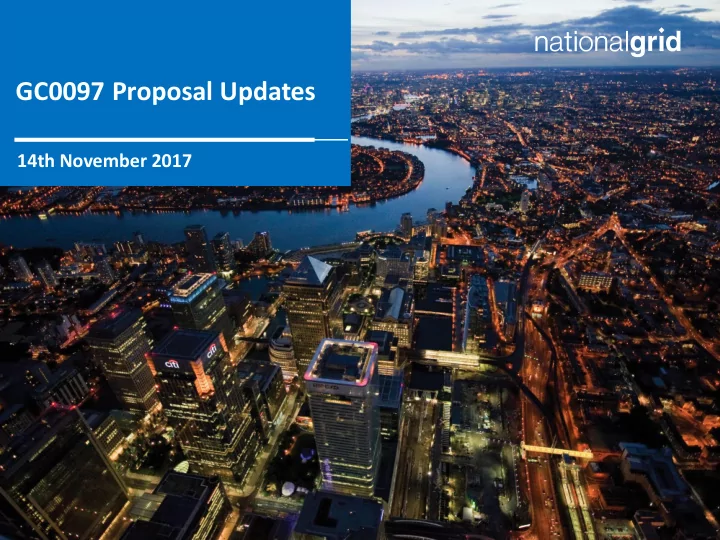

GC0097 Proposal Updates 14th November 2017
Pre-qualification Requirements
System Operator Guidelines (SOGL) Article 162 – RR prequalification process A potential RR provider shall demonstrate….. that it complies with RR technical minimum requirements … in Article 161 Within 8 weeks of receiving the formal application the TSO shall confirm that the application is complete (in terms of information required) If the application is incomplete the RR provider shall provide the additional required information within 4 weeks of the request from the TSO (if the provider does not comply the application is deemed to be withdrawn) Within 3 months from the confirmation of completeness the TSO shall confirm if the potential RR provider meets the criteria for prequalification Qualification will be reassessed At least once every five years Where technical requirements or equipment changes 3
System Operator Guidelines (SOGL) Article 161 – RR minimum technical requirements Shall comply with activation and de-activation according to set point from TSO Time stamped scheduled active power output for each RR providing unit and group (and each generating module or demand unit of a RR group) with maximum active power >= 1.5MW Time stamped instantaneous active power output for each RR providing unit and group (and each generating module or demand unit of a RR group) with maximum active power >= 1.5MW Fulfilment of availability requirements TSO shall specify RR availability requirements and requirements for control quality The RR provider will inform the TSO about actual availability or forced outage 4
Proposals Prequalification: All BMUs will be considered to have already prequalified as RR providers National Grid will assume that the details and evidence provided as part of prequalification is correct and will not carry out onsite testing etc. (as per the current arrangements for STOR). Operational metering - level: SOGL provides down to 1.5MW, STOR is a minimum 3MW service and TERRE is minimum 1MW On its own an RR provider with a maximum of 1 MW will not have a large effect of frequency but given the service is at 1MW this cannot be ignored Either request operational metering at 1MW so that TERRE provision can be monitored 1.5MW to provide consistency with SOGL 3MW for consistency with STOR Recommend this be at 1MW 5
Proposals Operational metering - accuracy: STOR has a number of measures but the largest is an accuracy of 2.5% - adopt this for RR RR Availability – BMU playing in Balancing Mechanism For an RR provider that is also a BMU we can use MEL or MIL to limit availability By virtue of the fact that a RR provider submits an offer for a period we will assume they are available However – if while waiting for the RRA or even after issuing the RRI if the unit declares down MIL or MEL we will not instruct beyond this value and will issue a BOA to obey the limits RR Availability – For a secondary BMU A means to indicate a forced outage is still required for a problem which develops while waiting for an RRA or after the RRI is issued Either this could be a new “unavailability” signal or also use a MEL/MIL concept 6
Data Submission
EB GL Requirement: A reminder Provider ID Associated TSO Market balance area Offer type Minimum quantity (MW) Maximum quantity (MW) Price Exclusive offer identification number Linking offer identification number Starting & Ending time for the offer - Min 15 m max 60m Incremental size - the size of the steps by which a divisible offer may be partially accepted 8
Grid Code Requirement: National Grid Proposal Physical Notification (PN) – Baseline for any RR activations A PN will be required for every period for which offer(s) are submitted. Checking for a PN will be part of NG’s technical validation process For any offers received where no PN is submitted, or where parties have opted not to default their PN the offers will be rejected. For parties that are instructable via the BM the existing PN will be used. Run Up / Run Down rates For parties that are instructable via the BM these will be the same as the BM run-up/ run-down rates 9
Grid Code Requirement: National Grid Proposal The following data items will not be required for participating in TERRE: Maximum Export Limit (MEL), Maximum Import Limit (MIL), Stable Export Limit (SEL), Stable Import Limit (SIL). For any divisible bids submitted to LIBRA, the platform requires the minimum activation quantity to be specified. These values will be required for any units also participating in the BM to avoid breaching a units limits, but these will be obtained via BM data requirements. Minimum Zero Time (MZT), Minimum Non-Zero Time (MNZT). Any consequences of these values to being instructed in TERRE will need to be dealt with by BSPs. NG do not see a requirement for submitting these values…. 10
Defaulting Arrangements For PN data: Participants will have a choice of whether they wish their PNs to be defaulted once we have received a value. The alternative will be to submit an updated value each time a unit wishes to participate in TERRE For offer data Due to the fact that a new identification number needs to be generated for each offer going into TERRE and also the complex nature of some bid formats we will be unable to offer defaulting of offer data. Bulk submissions should provide some of the flexibility that would have been provided by offer defaulting. 11
Bulk Submission of Data BSPs will be able to submit offers for TERRE in bulk ahead of time. The rules for this will be in line with existing BM data submission arrangements: A maximum limit of data submission is equal to the end of the current Operational Day + 5 days 12
Recommend
More recommend